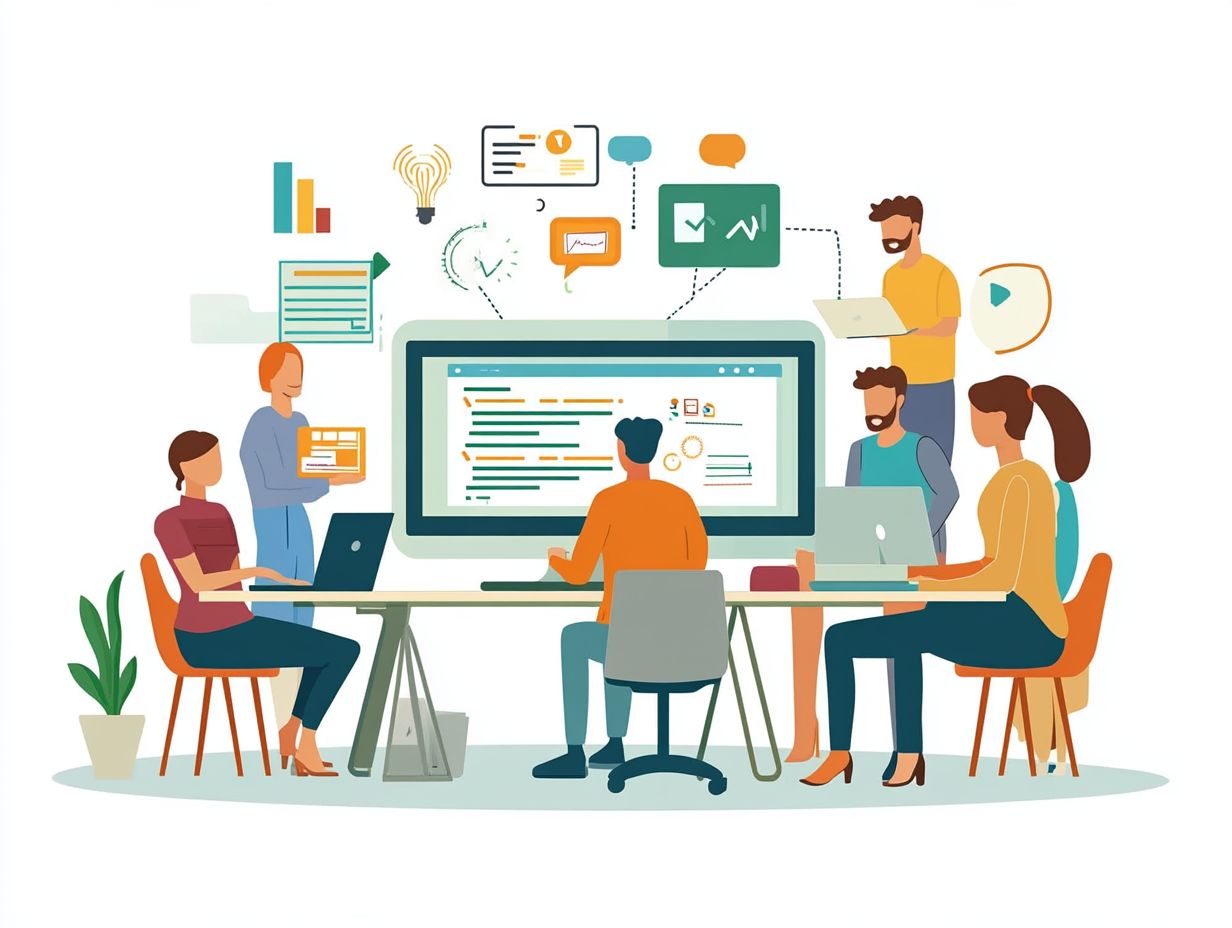5 Essential Skills for E-Learning Designers
In the ever-evolving landscape of education, e-learning designers hold a pivotal position in crafting engaging and effective digital learning experiences.
To truly excel in this domain, you must master five essential skills. From grasping instructional design principles to being proficient with e-learning authoring tools, each skill is a vital piece of the puzzle that contributes to the overall success of an e-learning program.
Let s dive into the skills you need to captivate your audience! This guide will arm you with the knowledge necessary to thrive in the dynamic realm of e-learning design.
Contents
- Key Takeaways:
- 1. Knowledge of Instructional Design Principles
- 2. Proficiency in E-Learning Authoring Tools
- 3. Understanding of Learning Management Systems
- 4. Ability to Analyze and Interpret Data
- 5. Strong Communication and Collaboration Skills
- What Is E-Learning and Why Is It Important?
- What Are the Key Components of Effective E-Learning Design?
- How Can Instructional Design Principles Be Applied in E-Learning?
- What Are the Most Commonly Used E-Learning Authoring Tools?
- How Can Learning Management Systems Enhance the E-Learning Experience?
- What Data Should E-Learning Designers Analyze and How Can It Inform Their Design?
- How Can E-Learning Designers Effectively Communicate and Collaborate with Others?
- Frequently Asked Questions
- What are the 5 essential skills for e-learning designers?
- How does instructional design play a role in e-learning design?
- Why is visual design important in e-learning?
- What technical skills should e-learning designers have?
- How does communication play a role in e-learning design?
- Why is project management important for e-learning designers?
Key Takeaways:

- Understand instructional design principles to create engaging courses.
- Be proficient in e-learning authoring tools to craft interactive content.
- Gain knowledge of learning management systems to enhance the experience for both learners and designers.
1. Knowledge of Instructional Design Principles
A comprehensive understanding of instructional design principles is crucial for you to create effective learning experiences that cater to the diverse needs and preferences of learners. This knowledge ensures that your educational materials are not only engaging but also educational. It covers various aspects, including adult learning theory and how much information a learner can handle at once, as well as the application of instructional frameworks like ADDIE (a step-by-step instructional design framework) and Bloom s Learning Taxonomy (a classification of learning objectives).
When you include adult learning theory in your course content, it s important to recognize that adults bring invaluable experience and a desire for practical, relevant learning. For example, incorporating case studies or real-world scenarios can help bridge the gap between theory and practice, enhancing both relevance and retention.
Managing cognitive load with techniques like chunking information and using visual aids helps learners process complex concepts. A perfect illustration of this can be found in corporate training programs, where simulations and role-playing exercises foster an interactive learning environment.
These applications not only boost comprehension but also instill confidence, ultimately leading to improved performance in real-world situations.
2. Proficiency in E-Learning Authoring Tools
Proficiency in e-learning authoring tools is essential for you as an instructional designer, enabling you to craft engaging and interactive learning experiences. Utilizing strategies for effective e-learning content can help you effectively convey knowledge and skills.
These platforms provide a wealth of functionalities, ranging from simple video integration to intricate branching scenarios that mirror real-life situations. For example, Captivate allows you to develop scenario-based assessments that adapt based on learner responses, offering immediate feedback and promoting critical thinking. Similarly, OpenLearning’s community features can elevate collaboration, transforming traditional assessments into peer-reviewed projects.
Incorporating multimedia elements like quizzes, videos, and infographics can significantly enhance learner engagement by catering to diverse preferences. This approach not only enriches the learning experience but also creates a dynamic and enjoyable educational journey for everyone involved.
3. Understanding of Learning Management Systems
A deep understanding of Learning Management Systems (LMS) is essential for you as an instructional designer. These platforms are the backbone for delivering digital learning and tracking learner progress.
Familiarity with the user interface and cloud-based capabilities of systems like Moodle, Blackboard, and SharePoint enables you to customize learning experiences that cater to diverse learner needs.
By implementing effective feedback loops which are processes for providing learners with ongoing information about their performance and performance metrics which measure how learners are doing you can ensure continuous improvement. This adaptability enhances learner engagement and success.
The intuitive interfaces of these platforms make navigation a breeze. Both you and your learners can access course materials effortlessly. Cloud-based tools facilitate real-time updates and create collaborative learning environments that elevate the teaching and learning experience.
You can also analyze performance metrics such as course completion rates and user interactions to make data-driven enhancements. This feedback assists in refining content and helps identify areas where learners may struggle. By implementing targeted interventions, you can optimize educational outcomes.
4. Ability to Analyze and Interpret Data
The ability to analyze and interpret data is a critical skill for you as an instructional designer. It allows you to assess the effectiveness of your instructional materials and strategies.
By examining performance metrics and learner data, you can uncover valuable insights into how well learners engage with the content. These insights inform your instructional research and assessment development.
This process involves utilizing various methods to gather data, such as surveys, quizzes, and observational studies. Each method provides unique perspectives on learner behavior and needs.
By interpreting this data, you can refine your assessments to better align with learning objectives, ensuring you measure what truly matters. This analytical approach enables the development of feedback mechanisms that address learner progress and cultivates a culture of continuous improvement.
Ultimately, by diving into data analysis, you can create powerful feedback mechanisms. These tailored interventions set the stage for more informed instructional decisions, leading to enhanced learning outcomes.
5. Strong Communication and Collaboration Skills

Strong communication and collaboration skills are absolutely essential for you as an instructional designer. These skills enable you to interact effectively with stakeholders, team members, and subject matter experts throughout the design process.
Honing these abilities facilitates the sharing of ideas and feedback. This ensures that your instructional content aligns perfectly with learner needs and organizational goals.
Through collaborative efforts and consistent feedback loops, you can enrich your storytelling techniques and elevate the overall quality of educational materials. This paves the way for successful professional development initiatives.
Engaging closely with subject matter experts gives you a deeper understanding of complex concepts. This insight allows you to craft clear and engaging narratives that truly resonate with learners.
Involving stakeholders in brainstorming sessions unveils diverse perspectives and expectations, guiding you toward more targeted learning outcomes. This collaboration fosters a sense of ownership among everyone involved.
It also significantly enhances the iterative nature of feedback, encouraging continuous improvement and innovation in your instructional strategies.
What Is E-Learning and Why Is It Important?
E-learning is a new way of learning that uses digital technologies to deliver content and create tailored learning experiences. Its importance lies in the flexibility, accessibility, and engagement it offers, fostering a culture of lifelong learning in our increasingly digital landscape.
By applying effective instructional design principles, you can craft e-learning experiences that maximize engagement and success, ultimately revolutionizing traditional educational paradigms.
This modern educational methodology integrates innovative tools like multimedia, interactive platforms, and virtual classrooms, all designed to cater to various learning styles. In this environment, you can progress at your own pace, addressing your unique understanding and retention levels.
The strategic application of instructional design enhances content delivery and encourages collaboration among peers an essential component for effective learning. As education continues to evolve, the dynamic nature of e-learning meets the needs of learners, teachers, and institutions alike, providing a versatile solution to the limitations of conventional education.
What Are the Key Components of Effective E-Learning Design?
Effective design includes essential components that guarantee you receive engaging and educational experiences. These elements include well-structured course content, captivating multimedia, appropriate management of how much information learners can handle at once, and robust feedback mechanisms that enhance your learning journey.
By weaving these components together, instructional designers can craft e-learning programs that foster active engagement and improve knowledge retention for a diverse audience.
For example, a logical flow in course content helps you build on what you already know, making the material more relatable and easier to grasp. Multimedia elements like videos, interactive simulations, and infographics cater to various learning styles, boosting your interest and motivation.
Managing cognitive load ensures that the content isn t overwhelming, striking the right balance to keep you focused. Timely and constructive feedback is crucial! It helps learners track their progress and make necessary adjustments, creating a dynamic learning environment that enables you to thrive.
How Can Instructional Design Principles Be Applied in E-Learning?
Ready to apply instructional design principles? Let s create amazing learning experiences together! You can effectively use these principles in e-learning to create educational experiences that resonate with your learners and cater to their unique needs. By leveraging frameworks such as adult learning theory and cognitive load theory, you can tailor your e-learning courses to maximize engagement and enhance the overall learning process.
This approach not only leads to more meaningful learning experiences but also fosters a sense of ownership and motivation among your learners.
For example, incorporating interactive multimedia elements allows visual and auditory learners to absorb information more effectively. Learning through real-life situations helps improve retention rates among employees, as it encourages them to apply their knowledge practically.
Regular quizzes to see how much you’ve learned throughout your e-learning modules can provide immediate feedback, guiding learners on their progress and highlighting areas for improvement. By utilizing these instructional design principles, your courses can become not just informative but transformative, leading to higher satisfaction and better educational outcomes.
What Are the Most Commonly Used E-Learning Authoring Tools?
A range of e-learning authoring tools awaits you, each with unique features that enable you to craft engaging and interactive content.
These tools address diverse educational needs, offering everything from straightforward quizzes to intricate branching scenarios, which are paths learners can choose based on their decisions. Take Captivate, for example; it s celebrated for its responsive design capabilities, ensuring your content looks fantastic on any device.
OpenLearning is another standout, fostering community engagement and allowing learners to interact and collaborate seamlessly.
Platforms like Coursera and edX focus on scalability, making it possible for institutions to reach vast audiences. By incorporating multimedia elements such as videos, audio, and animated graphics you can significantly enhance the learning experience, making it more immersive and effective.
By using these functionalities, you can design rich, interactive modules that not only educate but also inspire and motivate your learners.
How Can Learning Management Systems Enhance the E-Learning Experience?

Learning Management Systems (LMS) elevate your e-learning experience by offering a centralized platform for delivering, tracking, and managing educational content. These systems cater to diverse learner needs, featuring customizable tools, ways to measure how well learners are doing, and integrated feedback loops that drive continuous improvement in learning outcomes.
Incorporating progress-tracking tools enables you to monitor individual learner achievements and identify areas where students may struggle, ensuring timely interventions.
Customization options allow you to tailor courses to align with the unique preferences and learning styles of each user, creating a more personalized educational journey.
Feedback mechanisms, like quizzes and surveys, not only keep learners engaged but also provide valuable insights for refining your instructional strategies. By utilizing these features effectively, you can create interactive modules that captivate learner interest and maximize retention, while ensuring a thorough understanding of the material.
What Data Should E-Learning Designers Analyze and How Can It Inform Their Design?
As an e-learning designer, you should analyze a variety of data to guide your design decisions and improve learning outcomes, focusing on performance metrics and learner analysis. This data provides insights into how learners interact with content, enabling you to refine instructional strategies and enhance assessment development.
Monitoring various performance indicators, such as completion rates, assessment scores, and time spent on tasks, is crucial. Gathering qualitative learner feedback through surveys and interviews offers richer context regarding user experiences.
When you leverage this diverse data, you’ll spot patterns and trends that highlight areas for improvement.
Ultimately, this informed approach not only drives continuous improvement in course design but also ensures that assessments align seamlessly with learning objectives, creating a more engaging and productive educational environment.
Ready to explore more about e-learning tools? Start using an LMS today for better results!
How Can E-Learning Designers Effectively Communicate and Collaborate with Others?
Effective communication and collaboration are vital for e-learning designers. They enable seamless interaction with stakeholders, subject matter experts, and team members throughout the design journey.
This teamwork improves the quality of the e-learning experience. It also fosters a sense of ownership and accountability within the design process.
Build strong relationships by scheduling regular touchpoints with stakeholders. Consider weekly check-ins or collaborative workshops to align expectations and gather insights.
Actively listening and adjusting your strategies based on stakeholder feedback is essential for building trust and a genuine sense of partnership.
Employing surveys or focus groups at various project stages allows you to collect diverse perspectives. This enhances the relevance and effectiveness of your learning materials. By embracing this approach, your team creates an exciting, dynamic learning framework that keeps evolving, ultimately delivering a richer experience for learners.
Frequently Asked Questions
What are the 5 essential skills for e-learning designers?
The essential skills for e-learning designers include instructional design, visual design, technical skills, communication, and project management.
How does instructional design play a role in e-learning design?

Instructional design involves creating effective and engaging learning experiences by understanding learner needs, setting clear objectives, and designing appropriate materials and activities.
Why is visual design important in e-learning?
Visual design is crucial in e-learning as it enhances the learning experience. It utilizes graphics, images, and layout to make content more engaging and memorable for learners.
What technical skills should e-learning designers have?
E-learning designers should possess technical proficiency in using e-learning authoring tools, along with knowledge of learning management systems software that helps manage and deliver e-learning content. Additionally, they can benefit from following 5 tips for designing mobile-friendly e-learning and other technology commonly used in the field.
How does communication play a role in e-learning design?
Effective communication is essential for e-learning designers to collaborate with subject matter experts, stakeholders, and team members. It also helps in presenting ideas and designs to clients or learners.
Why is project management important for e-learning designers?
E-learning design projects can be complex, involving multiple tasks, deadlines, and stakeholders. To ensure success, incorporating ways to enhance accessibility in e-learning is crucial. Project management skills enable e-learning designers to plan, organize, and deliver projects efficiently and effectively.






